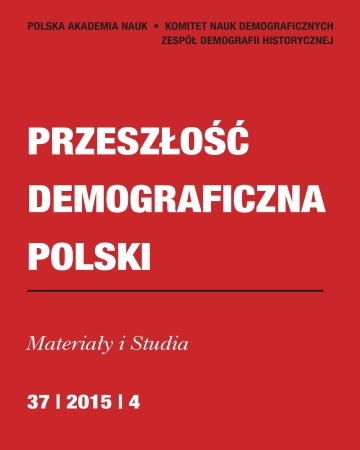








| Authors: |
Yuriy
Voloshyn
Poltava National Pedagogical University named after V.G. Korolenko, Department of Ukrainian History |
| Keywords: | widows widowers Poltava Hetmanate household family |
| Data publikacji całości: | 2015 |
| Page range: | 22 (39-60) |
| 1. | Bellingham, R. (Autumn 1998) Age at marriage in the late-eighteenth century. Local Population Studies 61, 54−56. |
| 2. | Central State Historical Archive of Ukraine in Kyiv (CSHAUK). Fund 57, Register. 2, Case. 166. |
| 3. | Fauve-Chamoux, A. (2008) Służba domowa w Europie od XVI wieku: dzieje i źródła zjawiska, in: Kuklo, C. (ed.): Rodzina i gospodarstwo domowe na ziemiach polskich w XV-XX wieku: struktury demograficzne, społeczne i gospodarcze. Warszawa,315−328. |
| 4. | Froide, A. M. (2002) Hidden women: rediscovering the single women of early modern England. Local Population Studies 68, 26−41. |
| 5. | Gramm, M. I. (2000) Zanimatelnaya entsiklopediya mer, edinits i deneg. Chelyabinsk. |
| 6. | Hammel, E. A., Laslett P. (Jan. 1974) Comparing Household Structure over Time and between Cultures. Comparative Studies in Society and History 16 (1), 73−109. |
| 7. | Istoriya zhenshchin na Zapade, t.ІІІ: Paradoksy epokhi Vozrozhdeniya i Prosveshcheniya, SPb. 2008. |
| 8. | Karpiński, A. (1983) Pauperes. O mieszkańcach Warszawy w XVI-XVII wieku. Warszawa. |
| 9. | Klassen, S. (2001) Widows and Widowers, in: Stearns P. N. (ed.): Encyclopedia of European social history from 1350 to 2000, vol. 4. Detroit, New York, San Francisco, London, 207−208. |
| 10. | Kobylets’kyy, M. (2013) Pravovyy status zhinky za Mahdeburz’kym pravom, Visnyk L’vivs’koho universytetu. Seriya yurydychna 58, 55−61. |
| 11. | Kovalenko, O. (2015) Poltava XVII–XVIII st. Kyyiv. |
| 12. | Kuklo, C. (2009) Demografia Rzeczypospolitej przedrozbiorowej. Warszawa. |
| 13. | Kuklo, C. (1998) Kobieta samotna w społeczeństwie miejskim u schyłku Rzeczypospolitej szacheckiej. Studium demograficzno-społeczne. Białystok. |
| 14. | Perkovs’kyy, A. L. (1968) Ukrayins’ke naselennya v 60-70-kh rokakh XVIII st., Ukrayins’kyy istorychnyy zhurnal 1, 107−111. |
| 15. | Misto Poltava v Rumyantsevs’komu opysi Malorosiyi 1765–1769 rr. (2012) Kyyiv. |
| 16. | Narodni prysliv‘ya ta prykazky. (1983) Kyiv. |
| 17. | Petrenko, I. M. (2010) Shlyubno-simeyni vidnosyny v povsyakdennomu zhytti myryan Rosiys’koyi derzhavy XVIII st. ch. 1. Poltava. |
| 18. | Poniat, R. (2014) Służba domowa w miastach na ziemiach polskich od połowy XVIII do końca XIX wieku. Warszawa. |
| 19. | Serdyuk, I. (2008) Vdivtsi i vdovy u Rumyantsevs’komu opysi Pereyaslava (Istorykodemohrafichnyy analiz). Krayeznavstvo 1−4, 175−181. |
| 20. | Serdyuk, I. (2010) Povtorni shlyuby v Het’mnshchyni u druhiy polovyni XVIII st. (Za danymy metrychnoyi knyhy Khrystorozhdestvens’koyi tserkvy mistechka Yares’ky Myrhorods’koho polku). Krayeznavstvo 3, 48−55. |
| 21. | Sklokin, V. V. (2009) Viys’kovi obyvateli Slobids’koyi Ukrayiny: intehratsiya do impers’koho suspil’stva (1765-1768rr.). Avtoreferat dysertatsiyi na zdobuttya naukovoho stupenya kand. ist. nauk. Kharkiv. |
| 22. | Statut Velykoho knyazivstva Lytovs’koho 1588 roku (2004) kn.2. Odesa, 568. |
| 23. | Sydorenko, O. F. (1975) Istorychna metrolohiya Livoberezhnoyi Ukrayiny XVIII st. Kyiv. |
| 24. | Van Poppel, F. (Nov., 1995) Widows, Widowers and Remarriage in Nineteenth-Century Netherlands, Population Studies 49 (3), 421−441. |
| 25. | Voloshyn Y. (2016) Kozaky i pospolyti: Mis’ka spil’nota Poltavy druhoyi polovyny XVIII st. Kyyiv. |
| 26. | Voloshyn, Y. (2011) Zhinka-vdova y polkovomy misti Poltavi drygoi polovini XVIII ct. (za materialami Rumiancevskogo opisy Malorosii), Kyyivs’ka Starovyna 1, 13−32. |
| 27. | Voloshyn, Y. V. (2005) Rozkol’nyts’ki slobody na terytoriyi Het’manshchyny u XVIII st.: (istорико-demohrafшчний aspekt). Poltava. |
| 28. | Voloshyn, Y. (2015) Household composition and family structures of Ukrainian Cossacks in the Second Half of the eighteenth century, The History of the Family 20 (1), 141−157. |
| 29. | Zinoviyiv, K. (1971) Virshi, prypovisti pospolyti. Kyiv. |